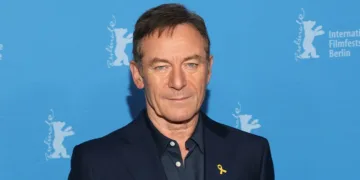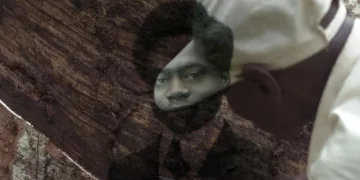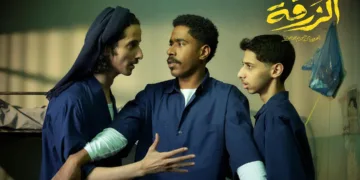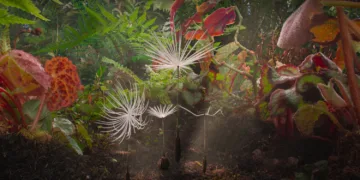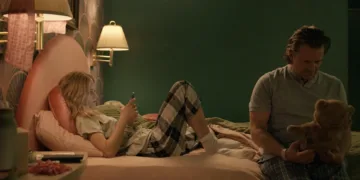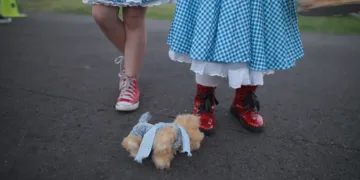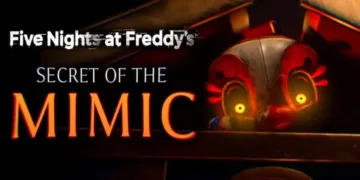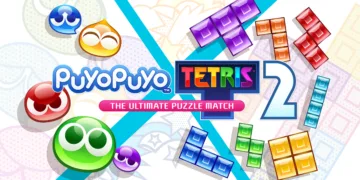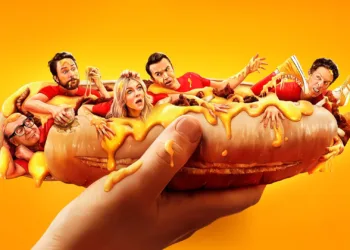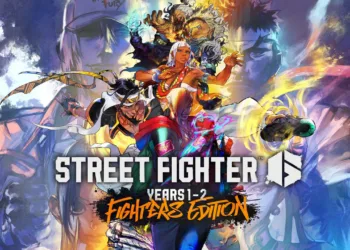Brendan Canty’s feature debut, Christy, premiered in Berlinale’s Generation 14plus strand—a fitting launchpad for a film that feels both intimate and elemental. Here, 17‑year‑old Christy (Danny Power) is unceremoniously expelled from Ireland’s care system and sent to live with his half‑brother, Shane (Diarmuid Noyes), in Cork’s rain‑slicked Knocknaheeny district. No sweeping exposition: the premise (a boy forced home just weeks before his eighteenth birthday) is stark, almost brutal in its simplicity.
Tonally, Christy occupies that liminal space between social‑realism and quiet lyricism. (Yes, there’s rap—unexpected, almost rebellious bursts of verse that puncture the gray drizzle.) Brendan Canty, formerly of Hozier’s “Take Me to Church” music video fame, brings a visually restrained palette—muted blues and grays give way to tentative warmth as Christy unfolds.
What sets this apart from the glut of urban‑drama fare is its locus: Cork, not Dublin. The vernacular “boy” punctuates every sentence, anchoring us in a community both tight‑knit and weather‑beaten. Beyond the setting, the film’s magnetic core lies in its performances: Power’s scowl‑to‑smile metamorphosis and Noyes’s taut restraint.
In under two hours, Christy stakes its claim as a modest yet resonant portrait of belonging—an Irish portrait that might just redefine “coming‑of‑age” for the margins.
The Pulse of Displacement
Canty’s Christy unfolds with a kinetic simplicity—Christy’s expulsion from foster care arriving like a blunt instrument, shattering any illusion of safety. (That relentless drizzle in Knocknaheeny isn’t atmospheric garnish; it’s an existential weight on his shoulders.) The inciting moment—Shane’s hesitating acceptance of custody mere weeks before Christy turns eighteen—reads less like plot mechanics and more like a historical echo of institutional abandonment, a microcosm of society’s failure to cradle its most vulnerable.
In Act I, the film thrives on silence: clenched fists around a soggy sandwich, furtive glances exchanged across a kitchen table. Then, abruptly, we’re gifted a rap refrain—an insurgent burst of youth voice against a gray backdrop. It jolts the narrative, signalling that Christy’s stasis won’t last.
The midpoint pivot—his discovery of barbering prowess and the birth of the “Christy Special”—marks a tonal thermostat shift. Colm Hogan’s camera, until now coolly observational, warms to match the community’s embrace.
Act II complicates this fragile equilibrium: a homeless woman’s fragile communion, Robot’s bonfire crew, and Shane’s internal tug‑of‑war between paternal duty and self‑preservation. Whispers of a hidden past (cousin’s confrontation) flicker like half‑remembered myths.
The climax arrives not as a bombastic reveal but a taut, wordless standoff—Christy’s fury against Shane’s buried dread. Neighbors intervene, solidarity crystallizing in shared defiance. And then: a final bonfire tableau, open‑ended yet oddly bright.
Short paragraphs, long silences, and the space between them carry the story—one that feels both hyper‑local and emblematic of collective displacement.
Fireside Kinship and Liquid Light
At its core, Christy interrogates the void left by institutional abandonment—what I’ve begun calling the “aging‑out abyss”—where children are shuffled until their eighteenth birthday, then unceremoniously released (a policy echoing Ireland’s grim Magdalene and mother‑and‑baby homes, albeit without the overt moralism). Christy’s fear of displacement becomes a micro‑thesis on state neglect, while Shane’s reluctant guardianship hints at familial repair as de facto social service.
Brotherhood here isn’t a tidy bond but a silent treaty (actions over words). Their unspoken grief for a deceased mother manifests in shared glances and hesitant touches—an elegy in half‑sentences.
In Knocknaheeny, the village replaces the ward. The barber shop and rap cypher morph into a modern meitheal—an ancient communal practice of shared labor now reinvested in art and adolescence. And that bonfire scene? Less cinematic flourish than a neo‑Celtic rite: fire as collective heartbeat, urging Christy out of his loner shell.
Anger and vulnerability dance a tight reel. One moment he’s a clenched fist; the next, a tremor‑handed vigil beside a homeless stranger. It’s contradictory, yes, but also authentic: rage as armor, empathy as breach.
Weather and light function almost as characters. The drizzle‑scape of Act I gives way to shafts of warmth—visual shorthand for Christy’s emotional thaw.
Rap isn’t window dressing; it’s his bardic voice. In lyrical bursts, Christy claims agency, forging solidarity through rhyme—proof that even in grayest environs, a new kind of Irish storytelling can ignite.
Portraits of Vulnerability and Resolve
Danny Power’s Christy is, at first glance, a living statue—rigid shoulders, furtive glances, a clenched‑jaw posture that recalls the lost youths of post‑industrial Dublin dramas (only here, the backdrop is Cork’s rain‑slicked streets). His transformation unfolds in increments: that first haircut montage (shears zinging like minor epiphanies), the tremor‑handed vigil beside a homeless stranger, the rap cypher finale where his voice cracks open. Power captures a boy forged by the care‑system’s “aging‑out rust” (my term for institutional neglect), yet capable of provisional warmth.
Silence.
Diarmuid Noyes’s Shane is restraint personified—every measured syllable carrying the weight of a man split between infant cries and the ghost of a brother he barely knows. He brooks no theatrics, yet frustration simmers beneath his composure. A single scene—Shane at the dinner table, gripping cutlery like a lifeline—speaks volumes about paternal paradox: protector and prisoner in one.
Stacey (Emma Willis) inhabits that middle ground between steel and silk. She offers Christy a seat by the hearth, juggles diaper changes with household counsel, and quietly deflects neighborhood smears. Her warmth feels functional rather than sentimental—a pragmatic heart that holds the makeshift family together.
Then there’s Robot (Jamie Forde), whose exuberant rap‑crew leadership supplies comic relief and cultural ballast. His bravado masks adolescent precarity. Alison Oliver’s homeless woman—brief yet indelible—serves as Christy’s mirror of empathy: a reminder that vulnerability can be elective.
Minor characters populate the barber‑shop pews and crumbling laneways, their Cork vernacular (“boy”) less dialect than communal heartbeat. Canty’s choice to cast locally rooted talent (some making their screen debuts) imbues every line with authenticity.
These performances don’t merely illustrate a script; they conjure a microcosm of social fracture and repair. Here, faces become symbols: Christy as the wounded archetype, Shane as the reluctant custodian, and the neighborhood as both scaffold and crucible—an ensemble of living reliquaries bearing witness to human resilience.
Lens, Sound, and the Rhythm of Belonging
Brendan Canty’s directorial debut betrays its music‑video lineage in more ways than one—those rap interludes snap and crackle like vinyl skips, quick cuts mirroring Christy’s internal jitter (a technique I’ve started calling “beat‑frame editing”). Yet Canty never lets style eclipse substance. His decision to marginalize adult figures (they exist in periphery, like ghosts in a Dickensian fable) keeps the narrative firmly in adolescent orbit, a deliberate act of social‑realist minimalism.
Colm Hogan’s cinematography functions as a sixth character. The initial color palette—desaturated blues and grays—reads almost clinical, a world stripped of comfort. When warmth creeps in (a shaft of sun through a barbershop window), it feels revolutionary. Hogan favors handheld framing at eye level, forging an intimacy that flirts with voyeurism. (One might accuse him of “cradle‑cam”—a Gentle Dardenne homage—yet it never feels exploitative.)
Production design roots Christy in tangible hardship. Knocknaheeny’s dilapidated estates—peeling paint, sagging porches—stand against vibrant community hubs: the ramshackle barber shop, the graffiti‑tagged schoolyard. Shell suits and threadbare streetwear aren’t costumes but second skins, marking class lines with unvarnished clarity.
Sound design and music weave the film’s emotional tapestry. Ambient cues—distant sirens, children’s laughter, rain patter—establish a diegetic heartbeat. Daithí’s score (traditional instruments filtered through subtle electronica) underscores emotional crescendos without sentimental heavy‑handedness. And the rap sequences—performed by local teens—are diegetic and diagnostic, revealing fractures in identity and unity in rhythm.
Editing orchestrates the film’s pulse. Contemplative scenes linger—long takes of Christy brooding by rain‑spattered windows—only to be punctured by vibrant, communal sequences: backyard barbecues, impromptu rap battles. The climax relies on cross‑cutting between Christy’s near‑explosive anger and the community’s mobilization, a montage that echoes wartime dispatches of solidarity (yes, a touch hyperbolic, but apt).
Technical precision meets raw authenticity. In Christy, every frame, every cut, every ambient hum conspires to translate a fractured adolescence into something resembling collective hope.
From Knocknaheeny to Kinship
Cork’s Northside—specifically Knocknaheeny—serves as more than backdrop; it is Christy’s unvarnished protagonist. (Rare, given Irish cinema’s Dublin‑centric gaze.) Here, the local vernacular—every sentence ending in “boy”—and landmarks like the derelict estates, the graffiti‑scarred schoolyard, the cluttered barber shop, ground the narrative in lived reality.
The film’s portrayal of the Irish foster system exposes its “aging‑out abyss”: children shuffled until their eighteenth birthday, then released without tether. Canty’s gaze echoes the moral reckonings of The Quiet Girl, yet he refuses sentimentality. Instead, he holds up a mirror to institutional neglect, inviting us to consider how societal “hand‑me‑down” failures become personal tragedies.
Community initiatives—Kabin Studio’s real‑world arts outreach, local rap crews, impromptu bonfires—aren’t cinematic fantasy but grassroots lifelines. They remind us that art and ritual can operate as makeshift welfare in areas left behind by policy. Think of post‑industrial towns where shutters shutter and yet festivals persist.
The socio‑economic reality is stark: peeling paint, malfunctioning streetlights, damp communal squares. Yet within this deprivation, family solidarity and “barber‑shop solidarity” emerge as survival tactics. In Knocknaheeny, everyone’s both caretaker and ward.
And perhaps that’s the film’s quiet manifesto: in places abandoned by systems, belonging must be forged, stitch by communal stitch.
Embers of Kinship and Hope
The final bonfire scene crackles as more than cinematic ornament—it becomes a collective exorcism of isolation. Flames lick the night air while Christy, once mute with distrust, stands amid a makeshift tribe. In that flicker of communal warmth, individual trauma yields to shared ritual (an echo, perhaps, of ancient clan gatherings where fire bound wanderers to hearth).
Christy’s arc—from a clenched‑fist loner to someone who smiles into the embers—feels almost archetypal. We’re meant to leave the cinema with a curious lightness. Ridiculously optimistic? Maybe. Yet under Canty’s gaze, hope doesn’t feel naïve; it feels earned.
The plot’s predictability—brotherhood restored, community rallying—occasionally smacks of genre boilerplate. Still, the authenticity of Power’s trembling‑hand moments, Noyes’s silent reckonings, and Hogan’s weather‑worn frames outweigh any formulaic beats.
Visually, Christy excels: gray skies give way to amber glows, each hue marking emotional thresholds. Performances radiate sincerity, never veering into melodrama. That balance—grit tempered by tenderness—is the film’s signature.
As a launchpad for Danny Power and Brendan Canty, Christy may well spark a wave of stories from Ireland’s peripheries. It stakes its claim in the resurgence of Irish cinema that looks beyond Dublin spires toward overlooked communities.
For anyone craving social‑realist nuance, a fresh coming‑of‑age portrait, or a cinematic bonfire that warms more than skin, Christy is essential viewing.
The Review
Christy
Christy harnesses raw performances, intimate visuals, and community spirit to deliver a hopeful, grounded portrayal of belonging. While its narrative arc may lean familiar, its emotive authenticity and the chemistry between Power and Noyes elevate every scene. Brendan Canty’s debut announces a new voice attuned to the margins, turning moments of rain and rap into quiet triumphs.
PROS
- Raw, authentic performances (especially Danny Power’s nuanced turn)
- Evocative cinematography that mirrors emotional shifts
- Warm portrayal of community solidarity (“barber‑shop solidarity,” if you will)
- Smart use of rap interludes to give voice to youth
CONS
- Plot beats occasionally feel familiar
- Some supporting threads (e.g., Alison Oliver’s character) underdeveloped
- Persistent gray palette can verge on monochrome















